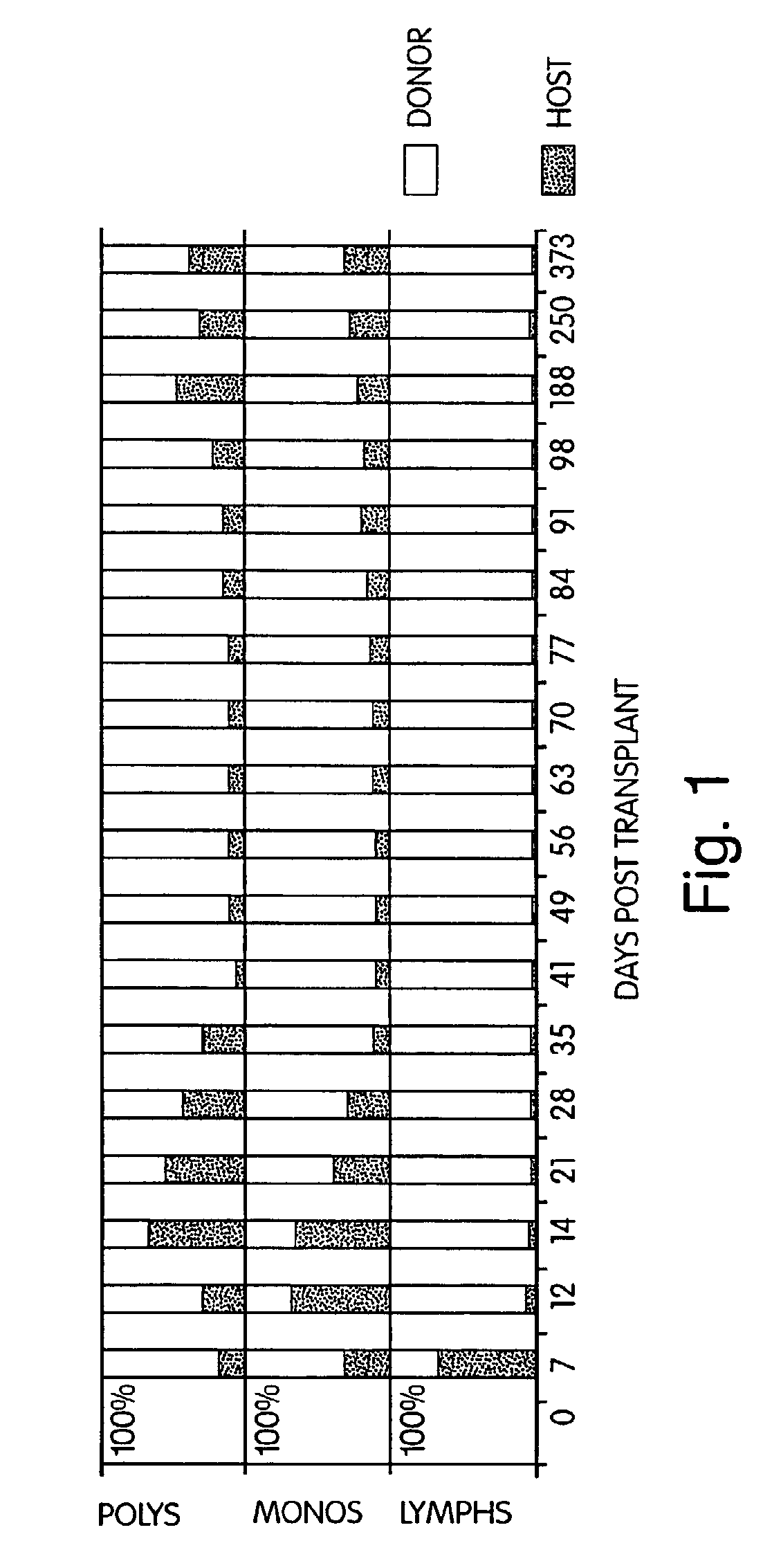Treatment of hematologic disorders
a technology for hematologic disorders and bone marrow transplantation, which is applied in the field of treatment of hematologic disorders, can solve the problems of increased engraftment failure and leukemic relapse rate, bone marrow transplantation (bmt) has yet to realize its full potential for the treatment of hematologic malignancies, and graft-versus-host disease (gvhd), so as to reduce gvhd and achieve significant gra
- Summary
- Abstract
- Description
- Claims
- Application Information
AI Technical Summary
Benefits of technology
Problems solved by technology
Method used
Image
Examples
example 1
Mixed Lymphohematopoietic Chimerism Following a Non-Myeloablative Conditioning Regimen and Allogeneic Bone Marrow Transplant (BMT)
[0276]Five patients with chemotherapy (n=5) and radiation (n=2) refractory non-Hodgkin's lymphoma were treated with cyclophosphamide (Cy) 50 mg / kg daily×4 (days −6 through −3), anti-thymocyte globulin 30 mg / kg (days −2, −1, +1) thymic irradiation 700 cGy×1 (n=3) (day −1) and HLA genotypically identical (n=2), phenotypically identical (n=1), or 2 antigen mismatched donor BMT (day 0). Intravenous cyclosporine (CYA) was given beginning on day −1 with conversion to p.o. CYA when tolerated. Donor leukocytes (DLI) were given on days +35, (107 / kg CD3+ cells) and +56 (5×107 / kg CD3+ cells) if no GVHD was present. Median patient age was 30 (range 20-45) years. All patients had disease progression during salvage chemotherapy or radiation therapy. Toxicities have included reversible Cy cardiotoxicity (n=1), and capillary leak syndrome coincident with engraftment (n=4...
example 2
Activation-Induced Cell Death in Donor TCR Transgenic T Cells with Known Host Antigen Specificity
[0277]The expansion and elimination of donor T cell receptor (TCR) transgenic T cells with known host antigen specificity was examined in a murine BMT model. In 2C T-cell receptor transgenic mice (H-2b on B6 background), a large fraction of T cells express CD8 and the αβ T-cell receptor from the cytotoxic T lymphocyte clone 2C, which specifically recognizes the MHC class I antigen Ld (Sha, W. C. et al., Nature 335, 271-274 1988). Lethally irradiated, Ld+ BALB / c (H-2d)mice were transplanted with 10×106 spleen cells from anti-Ld 2C TCR-transgenic B6 mice. By 4 days after BMT, the numbers of 2C CD8 cells in the spleens of BALB / c recipients had increased 14-16 fold over the number administered. However, they had drastically decreased to similar numbers to those administered by day 7. By 3-color FCM using 7-AAD (amino-actinomycin-D) for DNA staining, we found that an increasing fraction (4-11...
example 3
Mixed Lymphohematopoietic Chimerism and Graft-vs-Lymphoma Effects are Achievable in Adult Recipients Following Non-Myeloablative Therapy and HLA-Mismatched Donor Bone Marrow Transplantation
[0278]Methods: Five patients with refractory non-Hodgkins lymphomas underwent BMT from two of six HLA antigen-mismatched (in the GVH direction) donors. Conditioning included pre-transplant cyclophosphamide, pre- and post-transplant anti-thymocyte globulin (ATG), and pre-transplant thymic irradiation. Additional GVHD prophylaxis consisted only of cyclosporin A.
[0279]Findings: Four of four evaluable patients engrafted, and mixed hematopoietic chimerism was established, with donor lymphoid predominance and varying levels of myeloid chimerism. Two patients are in GVHD-free complete and partial clinical remissions at 460 and 103 days post-BMT, respectively.
[0280]Interpretation: This is the first demonstration that mixed chimerism can be intentionally induced in adult recipients of HLA-mismatched BMT. M...
PUM
 Login to View More
Login to View More Abstract
Description
Claims
Application Information
 Login to View More
Login to View More - R&D
- Intellectual Property
- Life Sciences
- Materials
- Tech Scout
- Unparalleled Data Quality
- Higher Quality Content
- 60% Fewer Hallucinations
Browse by: Latest US Patents, China's latest patents, Technical Efficacy Thesaurus, Application Domain, Technology Topic, Popular Technical Reports.
© 2025 PatSnap. All rights reserved.Legal|Privacy policy|Modern Slavery Act Transparency Statement|Sitemap|About US| Contact US: help@patsnap.com


